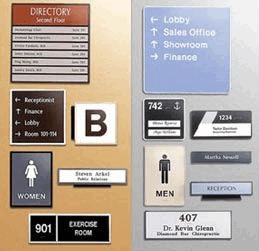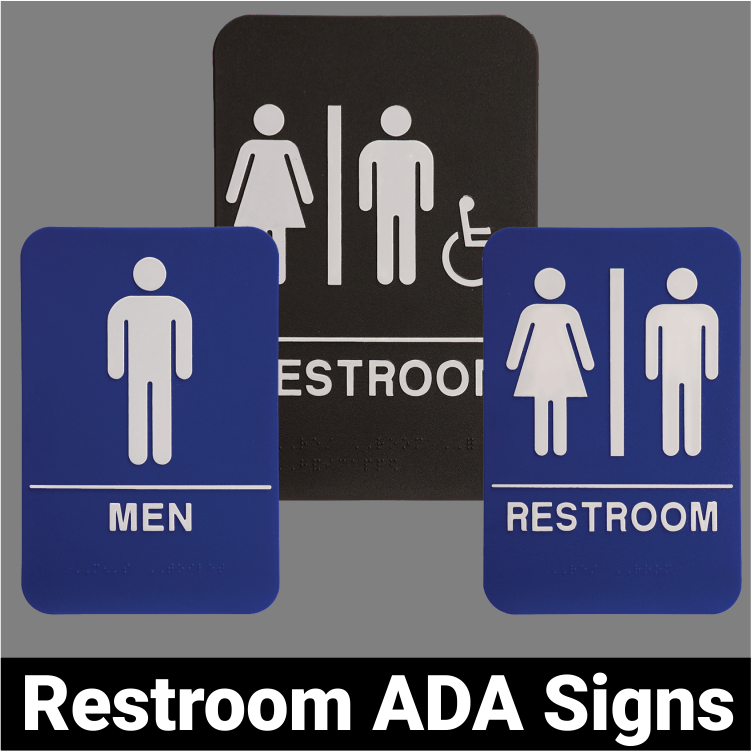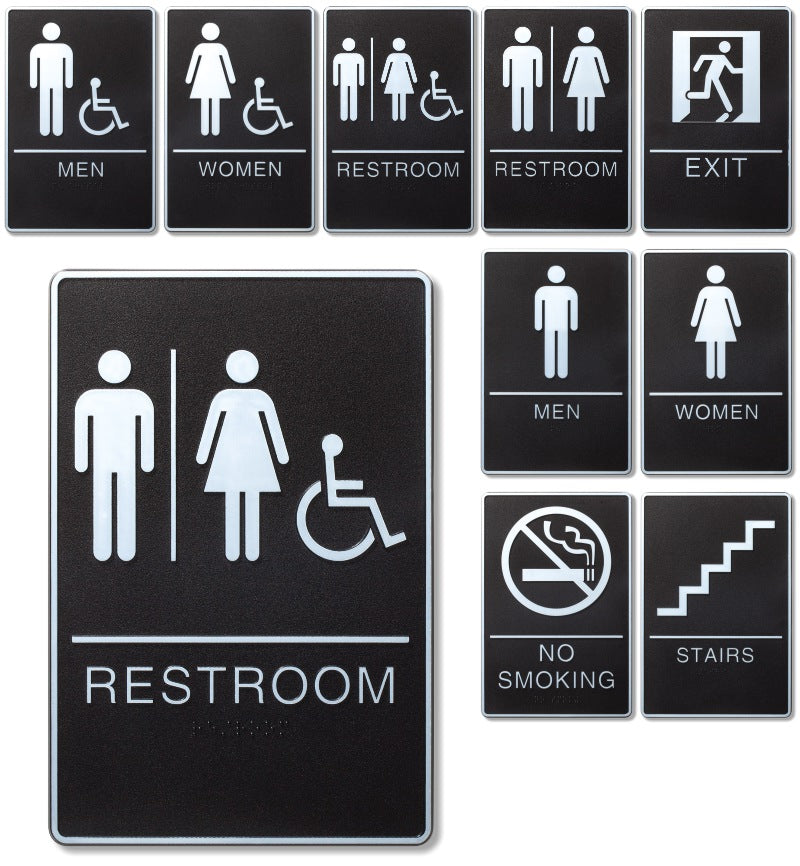Comprehending the Laws Behind ADA Signs
Comprehending the Laws Behind ADA Signs
Blog Article
Checking Out the Key Attributes of ADA Indicators for Enhanced Ease Of Access
In the realm of accessibility, ADA indications function as quiet yet effective allies, making sure that areas are accessible and comprehensive for people with specials needs. By integrating Braille and tactile aspects, these indications break obstacles for the aesthetically impaired, while high-contrast color systems and legible typefaces accommodate diverse visual needs. Their critical positioning is not arbitrary yet rather a computed initiative to promote smooth navigation. Past these functions lies a deeper story about the development of inclusivity and the recurring dedication to producing fair areas. What extra could these indicators signify in our quest of universal access?
Value of ADA Conformity
Making sure compliance with the Americans with Disabilities Act (ADA) is vital for fostering inclusivity and equivalent access in public rooms and workplaces. The ADA, passed in 1990, mandates that all public facilities, employers, and transport solutions suit individuals with impairments, guaranteeing they delight in the exact same civil liberties and chances as others. Compliance with ADA requirements not just fulfills legal commitments yet additionally boosts an organization's online reputation by showing its commitment to diversity and inclusivity.
One of the vital aspects of ADA compliance is the execution of obtainable signs. ADA indicators are made to ensure that individuals with handicaps can quickly browse via rooms and buildings.
Additionally, sticking to ADA policies can reduce the threat of legal effects and prospective fines. Organizations that stop working to abide with ADA standards may face charges or lawsuits, which can be both damaging and financially burdensome to their public picture. Therefore, ADA conformity is integral to fostering an equitable atmosphere for everybody.
Braille and Tactile Elements
The unification of Braille and responsive aspects right into ADA signage embodies the principles of accessibility and inclusivity. These features are important for people who are blind or aesthetically impaired, allowing them to browse public areas with higher freedom and confidence. Braille, a tactile writing system, is vital in providing written details in a style that can be quickly perceived through touch. It is normally positioned under the corresponding text on signs to ensure that people can access the details without visual support.
Responsive aspects expand beyond Braille and consist of elevated characters and icons. These components are developed to be discernible by touch, permitting people to determine room numbers, toilets, departures, and various other vital locations. The ADA sets certain standards relating to the size, spacing, and placement of these tactile aspects to enhance readability and make sure consistency throughout various environments.

High-Contrast Color Pattern
High-contrast shade systems play a pivotal role in improving the exposure and readability of ADA signs for people with visual impairments. These systems are vital as they take full advantage of the difference in light reflectance in between text and background, making sure that signs are quickly noticeable, also from a range. The Americans with Disabilities Act (ADA) mandates making use of particular color contrasts to suit those with minimal vision, making it a critical facet of compliance.
The efficacy of high-contrast colors exists in their capacity to stick out in different lights problems, including dimly lit settings and locations with glare. Typically, dark message on a light background or light text on a dark history is used to attain optimal contrast. Black message on a yellow or white background gives a plain aesthetic difference that helps in quick recognition and understanding.

Legible Fonts and Text Size
When taking into consideration the design of ADA signage, the choice of readable font styles and proper message dimension can not be overemphasized. These aspects are important for guaranteeing that indicators come to people with aesthetic impairments. The Americans with Disabilities Act (ADA) mandates that fonts need to be sans-serif and not italic, oblique, manuscript, highly attractive, or of uncommon kind. These needs assist make sure that the text is conveniently legible from a range which the characters are distinct to varied target markets.
According to ADA guidelines, the minimal text elevation this hyperlink should be 5/8 inch, and it needs to enhance proportionally with checking out range. Consistency in message size contributes to a natural visual experience, assisting individuals in browsing environments successfully.
Moreover, spacing in between lines and letters is integral to clarity. Adequate spacing stops characters from appearing crowded, boosting readability. By adhering to these requirements, developers can substantially improve access, ensuring that signage offers its intended function for all people, regardless of their visual capacities.
Effective Positioning Methods
Strategic placement of ADA signage is essential for making the most of accessibility and ensuring compliance with legal criteria. Properly positioned indications lead individuals with impairments effectively, facilitating navigating in public spaces. Trick considerations consist of elevation, proximity, and presence. ADA guidelines state look at this now that indications must be placed at a height in between 48 to 60 inches from the ground to guarantee they are within the line of sight for both standing and seated individuals. This standard height range is crucial for inclusivity, enabling wheelchair users and people of differing elevations to gain access to info effortlessly.
Additionally, indicators should be positioned adjacent to the lock side of doors to allow simple recognition prior to entry. Uniformity in sign placement throughout a facility boosts predictability, lowering complication and enhancing total individual experience.

Conclusion
ADA signs play an essential role in advertising accessibility by integrating features that attend to the requirements of individuals with impairments. Including Braille and responsive components makes sure vital info is easily accessible to the visually impaired, while high-contrast color design and readable sans-serif font styles boost presence throughout numerous lighting conditions. Efficient placement methods, such as ideal mounting heights and calculated places, additionally promote navigating. These elements jointly foster a comprehensive setting, underscoring the significance of ADA compliance in making sure equivalent accessibility for all.
In the world of availability, ADA indications offer as quiet yet effective allies, making sure that rooms are accessible and comprehensive for people with impairments. The ADA, established in 1990, mandates that all public facilities, companies, and transportation services fit individuals with specials needs, ensuring they appreciate the very same rights and possibilities as others. ADA Signs. ADA indications are designed to make certain that individuals with disabilities can easily browse with buildings and areas. ADA guidelines stipulate that indications should be placed at an elevation in between 48 to 60 inches from the ground to guarantee they are within the line of sight for both standing and seated people.ADA indications play an important duty in promoting accessibility by integrating features that attend to the needs of people with disabilities
Report this page